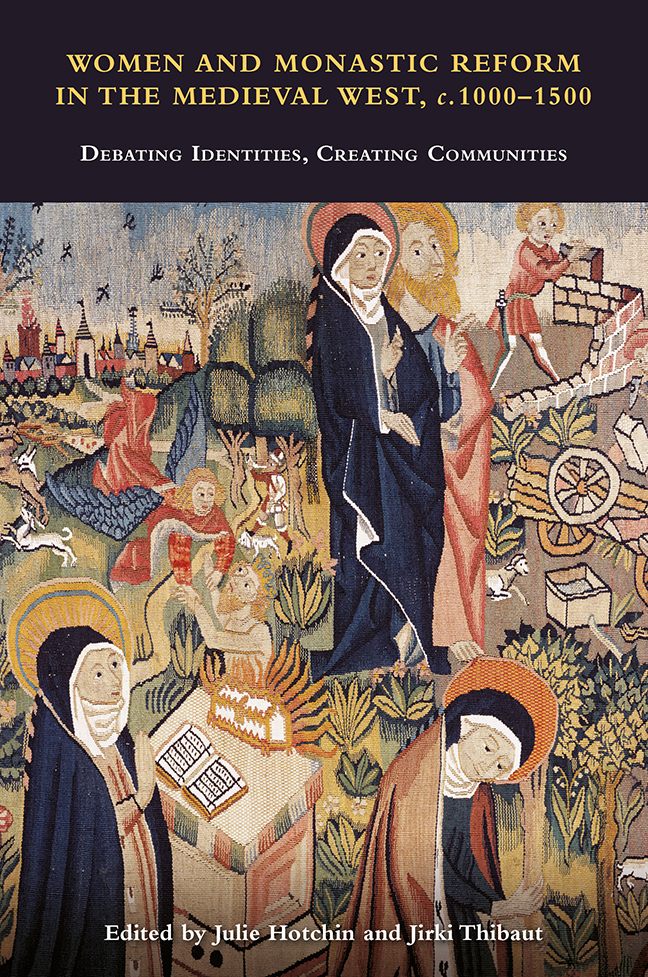 Women and Monastic Reform in the Medieval West, c.100-1500
Women and Monastic Reform in the Medieval West, c.100-1500 Book contents
- Frontmatter
- Dedication
- Contents
- List of Illustrations
- List of Contributors
- Acknowledgements
- List of Abbreviations
- 1 Debating Identities: Women and Monastic Reform in the Medieval West, c. 1000–1500
- 2 Liturgy and Female Monastic Hagiography Around the Year 1000: A lecture croisée of the Life of Liutrud, the Second Life of Glodesind of Metz and the So-called Pontificale Romano-Germanicum
- 3 Remakers of Reform: The Women Religious of Leominster and their Prayerbook
- 4 The Materiality of Female Religious Reform in Twelfth-Century Ireland: The Case of Co-located Religious Houses
- 5 Women as Witnesses: Picturing Gender and Spiritual Identity in a Twelfth-Century Embroidered Fragment from Northern Germany
- 6 Mulieres religiose and Cistercian Nuns in Northern Italy in the Thirteenth Century: A Choice of ‘Order’
- 7 Circulation of Books and Reform Ideas between Female Monasteries in Medieval Castile: From Twelfth-Century Cistercians to the Observant Reform
- 8 Women, Men and Local Monasticism in Late Medieval Bologna
- 9 Building Community: Material Concerns in the Fifteenth-Century Monastic Reform
- 10 Who Made Reform Visible? Male and Female Agency in Changing Visual Culture
- 11 Nuns, Cistercian Chant and Observant Reform in the Southern Low Countries
- Index
- Other volumes in Studies in the History of Medieval Religion
5 - Women as Witnesses: Picturing Gender and Spiritual Identity in a Twelfth-Century Embroidered Fragment from Northern Germany
Published online by Cambridge University Press: 09 January 2024
- Frontmatter
- Dedication
- Contents
- List of Illustrations
- List of Contributors
- Acknowledgements
- List of Abbreviations
- 1 Debating Identities: Women and Monastic Reform in the Medieval West, c. 1000–1500
- 2 Liturgy and Female Monastic Hagiography Around the Year 1000: A lecture croisée of the Life of Liutrud, the Second Life of Glodesind of Metz and the So-called Pontificale Romano-Germanicum
- 3 Remakers of Reform: The Women Religious of Leominster and their Prayerbook
- 4 The Materiality of Female Religious Reform in Twelfth-Century Ireland: The Case of Co-located Religious Houses
- 5 Women as Witnesses: Picturing Gender and Spiritual Identity in a Twelfth-Century Embroidered Fragment from Northern Germany
- 6 Mulieres religiose and Cistercian Nuns in Northern Italy in the Thirteenth Century: A Choice of ‘Order’
- 7 Circulation of Books and Reform Ideas between Female Monasteries in Medieval Castile: From Twelfth-Century Cistercians to the Observant Reform
- 8 Women, Men and Local Monasticism in Late Medieval Bologna
- 9 Building Community: Material Concerns in the Fifteenth-Century Monastic Reform
- 10 Who Made Reform Visible? Male and Female Agency in Changing Visual Culture
- 11 Nuns, Cistercian Chant and Observant Reform in the Southern Low Countries
- Index
- Other volumes in Studies in the History of Medieval Religion
Summary
Furnishing the church with textiles to mark liturgical feasts performed various commemorative, representative and identity functions for religious communities and patrons. Spiritually, they served as a metaphor for different kinds of spiritual adornment. Liturgical textiles dressed the church as Ecclesia, the bride of Christ, and provided visual imagery to focus and direct the meditation of the women and men who viewed them. Women, in particular, commissioned, donated or made liturgical textiles to clothe priests and dress the altars of their church, through which they claimed a female presence in the celebration of the Christian liturgy. From the tenth century women are also occasionally recorded as picturing themselves – or being pictured – prominently in textile imagery and other media as participants in these stories of sacred history. By projecting themselves into key scenes in sacred history, women expressed their relationship with Christ, chiefly at the Cross and the Tomb, and by extension with the men who supported their religious life. Liturgical textiles can yield evidence of how male and female members of a community expressed collective identities and devotional concerns. Examining these textiles, therefore, offers an alternate perspective from which to consider questions of gender, women's spiritual roles and their relations with the men who were responsible for their spiritual care.
This chapter examines a fragment of figural embroidery, now preserved in the Kunstgewerbemuseum in Berlin (Inv. No. 1888,470), as evidence of how women and men in religious life imagined gender roles in northern Germany in the later twelfth century (Fig. 5.1). The central scenes of the fragment depict two images of the Resurrection and Pentecost, with a border on two sides comprising figures of male saints and clerics. Female figures feature prominently in the textile's visual narrative of sacred history: three women are shown at the Tomb on Easter morning, the Virgin is seated among the apostles, and two nuns, arms outstretched in veneration, are embedded into the scenes of the Resurrection. Largely overlooked in the scholarly literature on this embroidered fragment, these embedded female devotional figures are one of the earliest, if not the earliest, examples of women religious depicted on an extant textile. Positioned as witnesses to the events unfolding before them, these female figures make striking claims for women's presence in sacred history and in the celebration of the liturgy at the centre of this unknown community's life.
- Type
- Chapter
- Information
- Women and Monastic Reform in the Medieval West, c.100-1500Debating Identities, Creating Communities, pp. 98 - 131Publisher: Boydell & BrewerPrint publication year: 2023


